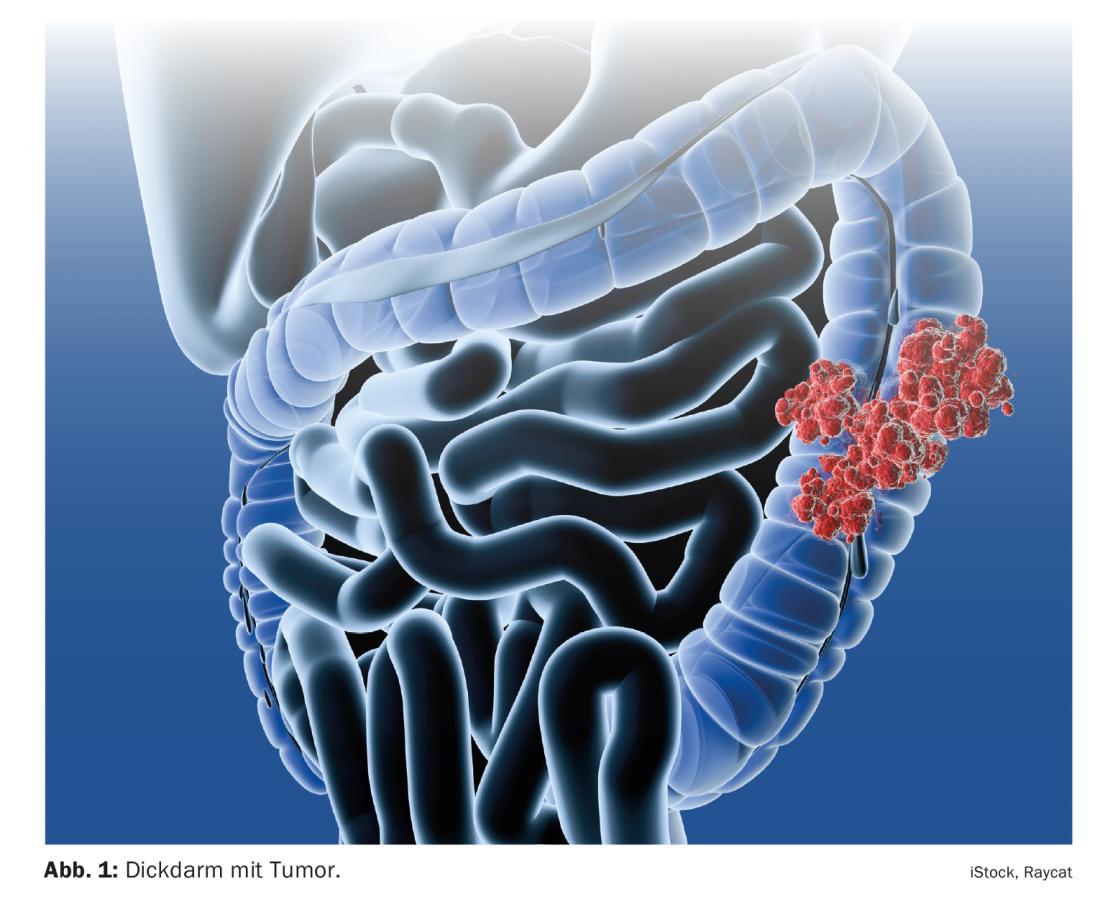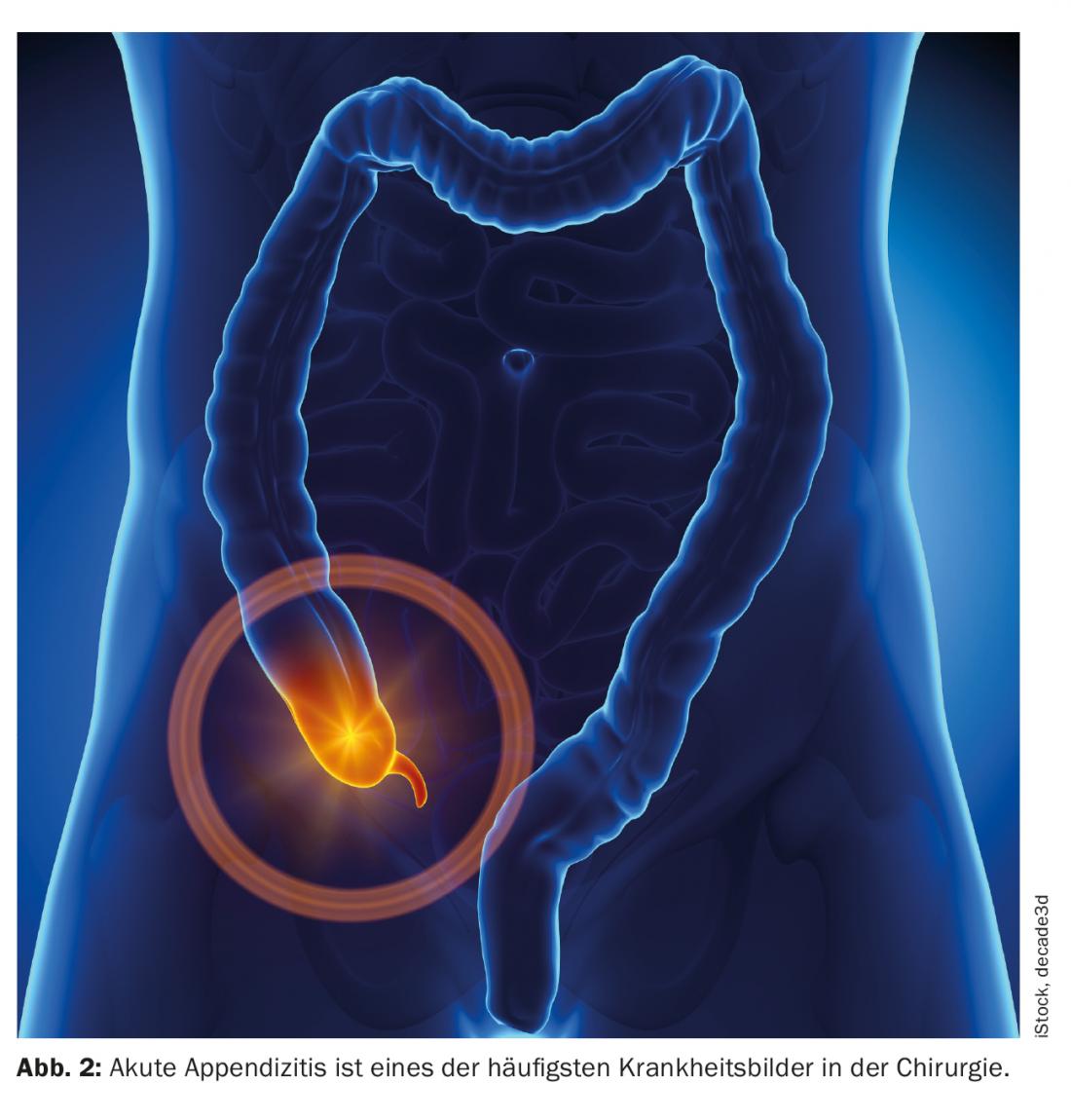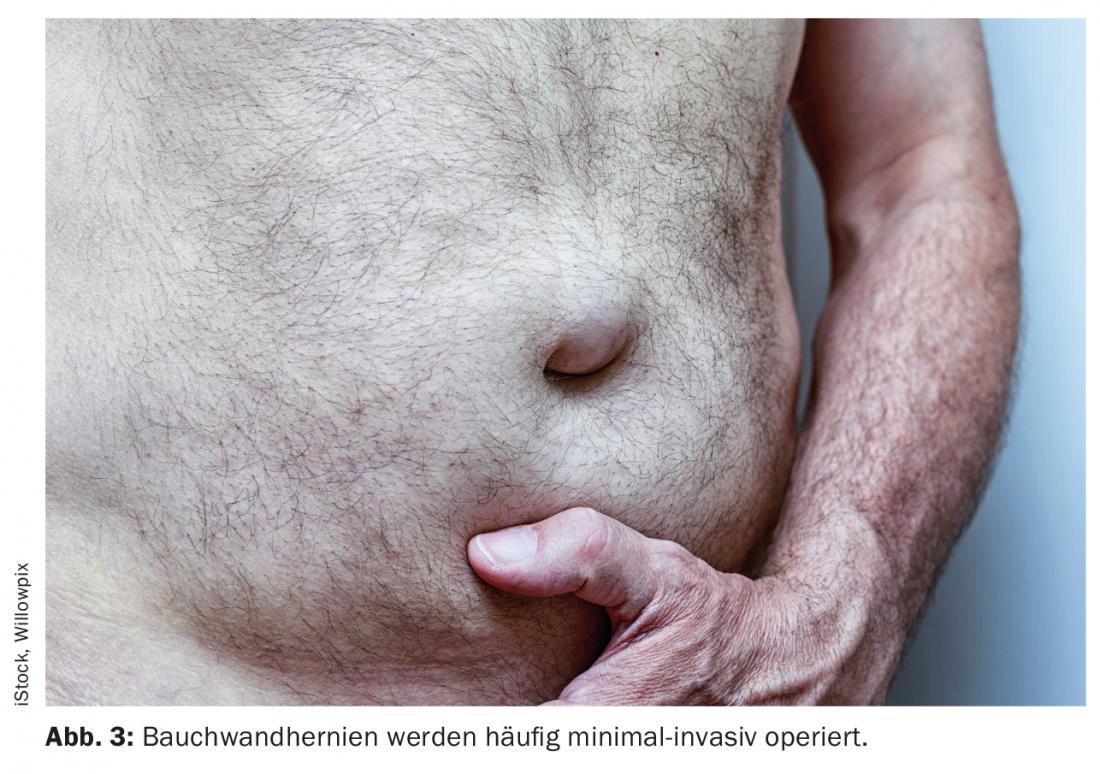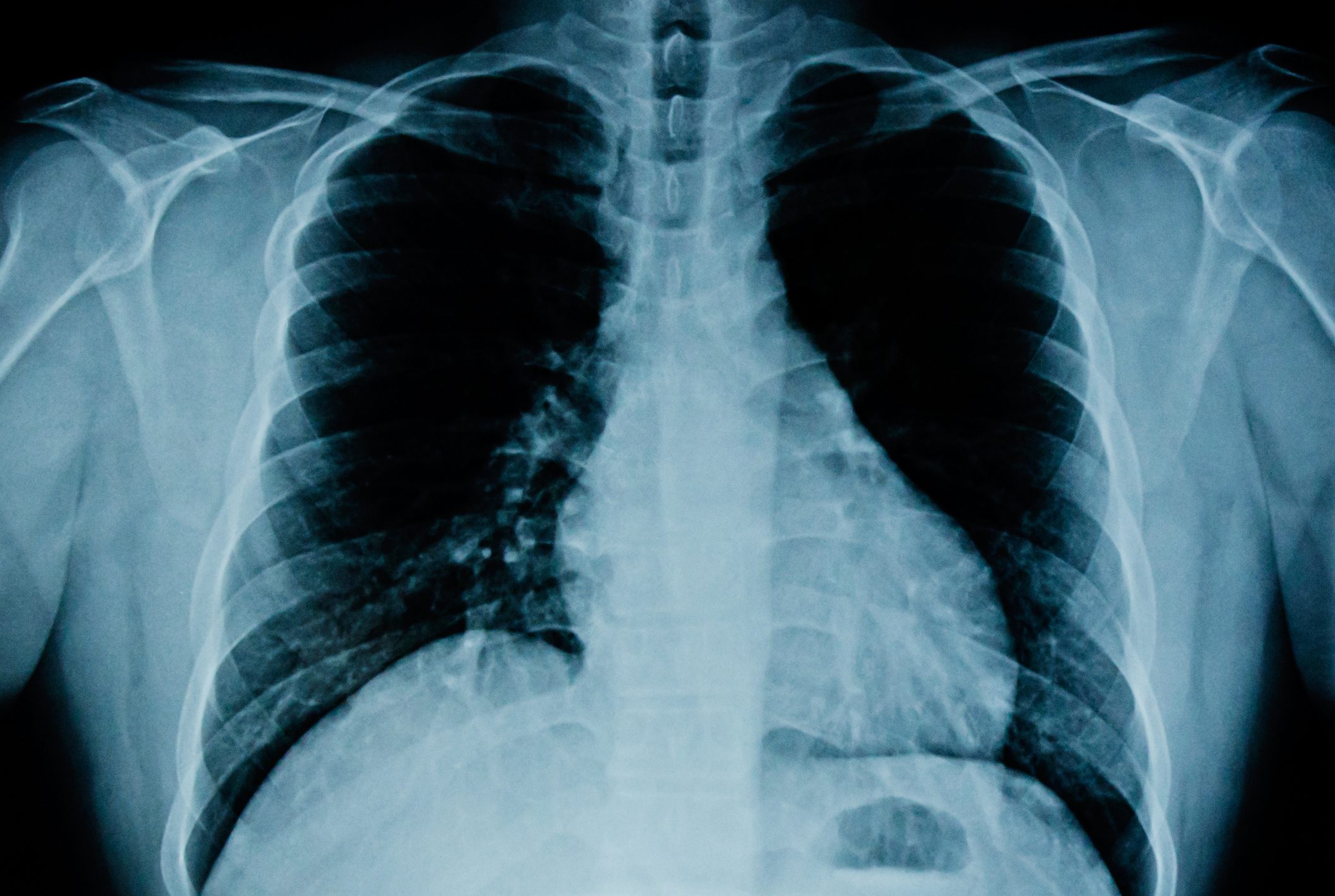Approximately 60 per 1000 population undergo abdominal surgery annually. The majority of patients are initially evaluated and triaged in the primary care physician’s office. Part 2 of the Visceral Surgery Update will cover aspects of the lower gastrointestinal tract, parietology, and perioperative management.
Part 1 of the Visceral Surgery Update appeared in the previous issue 1/2021 of HAUSARZT PRAXIS and addressed the upper gastrointestinal tract and gastrointestinal complications in COVID-19. Part 2 now addresses aspects of the lower gastrointestinal tract, parietology, and perioperative management. For methodology, please refer to the related information in Part 1.
Colorectal carcinoma
Colon and rectal cancer is one of the most common tumor diseases worldwide (Fig. 1). As a surgical strategy for this, the laparoscopic approach has already demonstrated advantages in terms of morbidity and hospital length of stay, and now also in oncological endpoints such as local recurrence rate and metastasis [1]. Prognostically important is complete mesocolic excision, which has also been shown in long-term studies to reduce the risk of recurrence by nearly 8%. In this procedure, lymph nodes are radically removed in the mesocolic layer along embryonic structures [2].

The most common long-term complication after deep rectal resection with continence preservation is low anterior resection syndrome (LARS) in up to 80% of patients. This can lead to incontinence, high stool frequency and other complaints. One possible therapeutic option is transanal irrigation therapy. Improvement in stool frequencies as well as incontinence rates may occur after only 4 weeks. However, long-term data are lacking, which is why the improvement in LARS symptoms cannot be attributed beyond doubt to irrigation therapy, but could also occur as part of spontaneous improvement [3].
In patients with uncontrollable stoma output and electrolyte leakage after protective ileostomy placement in the setting of tumor resection, stoma reoperation can be performed without increased perioperative complications even while chemotherapy is ongoing [4].
Diverticulitis
A meta-analysis compared administration of oral antibiotics with intravenous antibiotics for diverticulitis. It was found that oral therapy was not inferior to intravenous therapy. In uncomplicated diverticulitis, depending on the clinic, primary antibiotic therapy may also be omitted without exposing patients to increased risk (emergency surgery or recurrence) [5].
Acute appendicitis
Acute appendicitis is one of the most common clinical pictures in general surgery (Fig. 2) . Conservative, antibiotic therapy is always discussed. A meta-analysis examining antibiotic therapy for acute appendicitis showed treatment failure in more than one-third of patients, necessitating surgical therapy. However, there was no increased morbidity after surgical rehabilitation. Recurrence occurred in up to 20% of patients after antibiotic-treated appendicitis. Therefore, appendectomy remains the gold standard of acute appendicitis [6,7]. This was confirmed by a study published in NEJM in November 2020 [8].

Hemorrhoids
Anal bleeding is the leading symptom of hemorrhoids and should be further evaluated initially to rule out carcinoma. If hemorrhoids are confirmed, they are divided into 4 grades and treated differently. For 2nd degree hemorrhoids, rubber band ligation is the treatment of choice as a cost-effective procedure [9]. For higher grade circular hemorrhoids, stapler hemorrhoidopexy is the method of choice. Regarding recurrence rate, but also for segmental hemorrhoids, conventional hemorrhoidectomy remains the best therapeutic option [10,11].
Anal fistula and anal fissure
The acute form of anal fistula is the perianal abscess and should be drained first [12]. In definitive anal fistula repair, fistulectomy with primary sphincter reconstruction has the highest cure rates. Patient satisfaction was also highest here. The incontinence rate of about 10% was considered acceptable by the authors, with mostly only fecal smearing after defecation or wind incontinence [13].
A very comprehensive S3 guideline was published this year on anal fissure, a very common proctological condition. Clear recommendations regarding therapy of acute and chronic anal fissure could be made, whereby the therapy decision should be made individually in consideration of the risk for the development of fecal incontinence and the effectiveness of the treatment [14].
Fecal incontinence
The risk of anal incontinence is highest in women after multiple vaginal deliveries [15]. As a treatment option, sacral neuromodulator implantation (SNM) provides good long-term results. Sustained therapeutic success was observed even after necessary battery replacement. For constipation, no sustained effect has been demonstrated after SNM implantation, so this is not recommended [16].
Inguinal hernia
Open and minimally invasive procedures are still available as alternatives. In the United States, there is a trend toward robot-assisted surgery, which, however, has not shown clear benefits in terms of pain, wound infection, or quality of life in several studies. The cost aspect as well as the prolonged operation time are controversially discussed in several published studies [45 – 47]. To date, no clear advantages of robotic-assisted inguinal hernia surgery over conventional laparoscopic surgical techniques have been demonstrated.
Chronic groin pain can affect up to one-third of patients postoperatively. A -slightly faster convalescence and less foreign body sensation were noted after laparoscopic inguinal hernia surgery. Patients who already have severe pain due to the inguinal hernia preoperatively are more likely to benefit from a laparoscopic procedure. However, if chronic groin pain occurs postoperatively, adequate pain therapy with oral and local analgesics is recommended primarily for several weeks [20].
The recurrence rate has been shown to be dependent on the volume of surgery performed at each hospital. Thus, institutions with fewer than 75 hernia surgeries per year experience increased rates of complications and recurrences [21]. Inguinal hernias in women are per se an indication for surgery and should primarily be operated on minimally invasively [22].
Ventral abdominal wall hernias
After laparotomies, scar hernia may occur in up to 30%. These are usually treated via open retromuscular reticuloplasty. Incarcerations correlate with fracture size and location. Thus, hernias with a size of 3 – 4 cm carry a significantly higher risk of incarceration episodes than larger hernias. Obesity, diabetes mellitus, alcohol consumption, and constipation also play a role with regard to incarceration and morbidity. Here, a positive influence can be generated by optimizing the risk factors [23,24].
In terms of aesthetics, laparoscopic and robot-assisted procedures are of interest (Fig. 3). Compared to the open procedure, laparoscopic intraperitoneal onlay mesh (IPOM) offers lower morbidity but is no longer recommended due to the increased recurrence rate of 20% at 5 years and the increased rate of mesh complications (mesh erosion, fistula, ileus, etc.) [25,26].
Robotic-assisted hernia repair results in significantly longer operative time, increased costs, and a recurrence rate of 12% within the first 2 years and is also not currently recommended without reservation [26,27].
Antibiotics
A frequently discussed topic remains preoperative bowel preparation with or without antibiotic administration. Oral antibiotic administration has been shown to decrease rates of superficial wound infections, but rates of deep infections as well as anastomotic insufficiencies remain constant. Therefore, due to the burden of bowel preparation, it should not be performed as a standard procedure [28].
Enhanced recovery after surgery (ERAS)
Rapid recovery after surgery represents an important focus in surgery. The stress response with release of neuroendocrine mediators causes an imbalance of homeostasis with potential organ complications. To reduce or avoid these, the Fast Track concept was developed. Particular attention is paid to optimal pain management, avoidance of postoperative nausea, balanced volume management, minimization of access trauma, and rapid food buildup and mobilization [29].
After the concept of abstinence from nicotine and alcohol, nutritional supplementation, and rapid postoperative nutrition had already significantly reduced pulmonary complications and length of hospital stay in colorectal surgery, this effect could now also be demonstrated in gastric and hepatobiliary surgery. This can result in a risk reduction of 40-50% [57–59].
Malnourished patients present a major challenge perioperatively. Preoperatively, the nutritional status of patients at risk should be optimized with nutritional supplements. A Canadian study showed that decreased ERAS compliance had a significantly higher postoperative morbidity rate [33,34].
Loss of muscle mass leads to adverse effects on postoperative mobilization and pulmonary function with associated complications [35].
An important point is prehabilitation, which takes place in the interval between neoadjuvant therapy and subsequent surgery. Here, nutritional counseling, immunomodulating sip feeds, endurance training, and psychotherapy can positively influence postoperative morbidity and reduce hospital length of stay accordingly [36,37].
It should be critically mentioned that the standardized ERAS protocols partly contain already outdated recommendations and modern clinics partly apply the recommended professional concepts in a more developed form or adapted.
Take-Home Messages
- In colorectal surgery, complete mesocolic excision (CME, TME) improves the risk of recurrence by up to 8%. The risk of metastasis can also be reduced.
- Antibiotic therapy for acute appendicitis may be considered as a treatment option in exceptional cases. Because of the high recurrence rate, appendectomy remains the gold standard for acute appendicitis.
- The treatment decision for anal fissure should be made on an individual basis, weighing the risk of developing fecal incontinence and the effectiveness of the treatment.
- Chronic groin pain after hernia repair primarily requires adequate pain management with oral as well as local analgesics.
Literature:
- Chaouch MA, et al: Laparoscopic Versus Open Complete Mesocolon Excision in Right Colon Cancer: A Systematic Review and Meta-Analysis. World J Surg 2019; 43: 3179-3190.
- Bertelsen CA, et al: 5-year outcome after complete mesocolic excision for right-sided colon cancer: a population-based cohort study. Lancet Oncol 2019; 20: 1556-1565.
- Rosen HR, et al: Randomized clinical trial of prophylactic transanal irrigation versus supportive therapy to prevent symptoms of low anterior resection syndrome after rectal resection. BJS Open 2019; bjs5.50160.
- Hajibandeh S, et al: Meta-analysis of temporary loop ileostomy closure during or after adjuvant chemotherapy following rectal cancer resection: the dilemma remains. Int J Colorectal Dis 2019; 34: 1151-1159.
- Mege D, Yeo H: Meta-analyses of Current Strategies to Treat Uncomplicated Diverticulitis: Dis Colon Rectum 2019; 62: 371-378.
- Prechal D, et al: Antibiotic therapy for acute uncomplicated appendicitis: a systematic review and meta-analysis. Int J Colorectal Dis 2019; 34: 963-971.
- Podda M, et al: Antibiotic Treatment and Appendectomy for Uncomplicated Acute Appendicitis in Adults and Children: A Systematic Review and Meta-analysis. Ann Surg 2019; 270: 1028-1040.
- The CODA Collaborative. A Randomized Trial Comparing Antibiotics with Appendectomy for Appendicitis. N Engl J Med 2020; 383: 1907-1919.
- Coughlin OP, et al: Hemorrhoid Banding: A Cost-Effectiveness Analysis. Dis Colon Rectum 2019; 62: 1085-1094.
- Emile SH, et al: Transanal hemorrhoidal dearterialization (THD) versus stapled hemorrhoidopexy (SH) in treatment of internal hemorrhoids: a systematic review and meta-analysis of randomized clinical trials. Int J Colorectal Dis 2019; 34: 1-11.
- Xu L, et al: Transanal hemorrhoidal dearterialization with mucopexy versus open hemorrhoidectomy in the treatment of hemorrhoids: a meta-analysis of randomized control trials. Tech Coloproctology 2016; 20: 825-833.
- Sahnan K, et al: Persistent Fistula After Anorectal Abscess Drainage: Local Experience of 11 Years. Dis Colon Rectum 2019; 62: 327-332.
- Litta F, et al: Fistulotomy and primary sphincteroplasty for anal fistula: long-term data on continence and patient satisfaction. Tech Coloproctology 2019; 23: 993-1001.
- Marti L et al: S3 guideline: anal fissure: AWMF registry number: 081-010. coloproctology 2020; 42: 90-196.
- Larsson C et al: Anal incontinence after caesarean and vaginal delivery in Sweden: a national population-based study. The Lancet 2019; 393: 1233-1239.
- Widmann B, et al: Success and Complication Rates After Sacral Neuromodulation for Fecal Incontinence and Constipation: A Single-center Follow-up Study. J Neurogastroenterol Motil 2019; 25: 159-170.
- Prabhu AS et al: Robotic Inguinal vs Transabdominal Laparoscopic Inguinal Hernia Repair: The RIVAL Randomized Clinical Trial. JAMA Surg 2020; 155: 380.
- Abdelmoaty WF, et al: Robotic-assisted versus laparoscopic unilateral inguinal hernia repair: a comprehensive cost analysis. Surg Endosc 2019; 33: 3436-3443.
- Pokala B, et al: Minimally invasive inguinal hernia repair is superior to open: a national database review. Hernia 2019; 23: 593-599.
- Gutlic N, et al: Randomized clinical trial comparing total extraperitoneal with Lichtenstein inguinal hernia repair (TEPLICH trial). BJS 2019; 106: 845-855.
- Maneck M, et al: Hospital volume and outcome in inguinal hernia repair: analysis of routine data of 133,449 patients. Hernia 2020; 24: 747-757.
- the HerniaSurge Group, et al: Consensus on international guidelines for management of groin hernias. Surg Endosc 2020; 34: 2359-2377.
- The Hernia Club Members, et al: Risk Factors for Incarceration in Patients with Primary Abdominal Wall and Incisional Hernias: A Prospective Study in 4472 Patients. World J Surg 2019; 43: 1906-1913.
- Howard R, et al: Costs Associated With Modifiable Risk Factors in Ventral and Incisional Hernia Repair. JAMA Netw Open 2019; 2: e1916330.
- Lavanchy JL, et al: Long-term results of laparoscopic versus open intraperitoneal onlay mesh incisional hernia repair: a propensity score-matched analysis. Surg Endosc 2019; 33: 225-233.
- Köckerling F, et al: Laparoscopic IPOM versus open sublay technique for elective incisional hernia repair: a registry-based, propensity score-matched comparison of 9907 patients. Surg Endosc 2019; 33: 3361-3369.
- Bittner JG, et al: Management of a primary ventral incisional hernia: a survey of the International Hernia Collaboration. J Robot Surg 2020; 14: 95-99.
- Hata H, et al: Oral and Parenteral Versus Parenteral Antibiotic Prophylaxis in Elective Laparoscopic Colorectal Surgery (JMTO PREV 07-01): A Phase 3, Multicenter, Open-label, Randomized Trial. Ann Surg 2016; 263: 1085-1091.
- Bardram L, et al: Recovery after laparoscopic colonic surgery with epidural analgesia, and early oral nutrition and mobilisation. The Lancet 1995; 345: 763-764.
- Hwang DW, et al: Effect of Enhanced Recovery After Surgery program on pancreaticoduodenectomy: a randomized controlled trial. J Hepato-Biliary-Pancreat Sci 2019; jhbp.641.
- Lee Y, et al: Enhanced recovery after surgery (ERAS) versus standard recovery for elective gastric cancer surgery: A meta-analysis of randomized controlled trials. Surg Oncol 2020; 32: 75-87.
- Takagi K, et al: Effect of an enhanced recovery after surgery protocol in patients undergoing pancreaticoduodenectomy: A randomized controlled trial. Clin Nutr 2019; 38: 174-181.
- Martin L, et al: Implementation of an Enhanced Recovery After Surgery Program Can Change Nutrition Care Practice: A Multicenter Experience in Elective Colorectal Surgery. J Parenter Enter Nutr 2019; 43: 206-219.
- Schuetz P, et al: Individualised nutritional support in medical inpatients at nutritional risk: a randomised clinical trial. The Lancet 2019; 393: 2312-2321.
- Simonsen C, et al: Sarcopenia and Postoperative Complication Risk in Gastrointestinal Surgical Oncology: A Meta-analysis. Ann Surg 2018; 268: 58-69.
- Hughes MJ, et al: Prehabilitation Before Major Abdominal Surgery: A Systematic Review and Meta-analysis. World J Surg 2019; 43: 1661-1668.
- Adiamah A, et al: The Impact of Preoperative Immune Modulating Nutrition on Outcomes in Patients Undergoing Surgery for Gastrointestinal Cancer: A Systematic Review and Meta-analysis. Ann Surg 2019; 270: 247-256.
- Romero J, et al: Acute Appendicitis During Coronavirus Disease 2019 (COVID-19): Changes in Clinical Presentation and CT Findings. J Am Coll Radiol 2020; 17: 1011-1013.
HAUSARZT PRAXIS 2021; 16(2): 6-8













